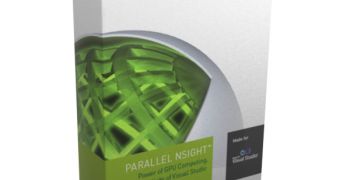Windows GPU development is making a key step forward in its evolution with the launch of NVIDIA Parallel Nsight. NVIDIA is essentially opening up the GPU computing universe to Visual Studio developers, by making possible an integrated development environment for both CPU and GPU. Designed as a plug-in for Microsoft’s development platform, Parallel Nsight delivers the industry’s first development environment for GPU-accelerated applications leveraging Visual Studio. Tested by 8,000 registered Beta developers, NVIDIA Parallel Nsight and Visual Studio are exponents of the perfect massively parallel programming marriage.
Two editions of Parallel Nsight 1.0 will be launched today, a Standard versions which has already been wrapped up, and the Release Candidate of the Professional flavor, that, obviously, is still in development, but also very close to finalization. Developers opting for Parallel Nsight 1.0 Professional will get a few extra features on top of the standard version, namely the CUDA C/C++ Analyzer, the OpenGL and OpenCL Analyzer, and the DirectX 10 & 11 Analyzer.
Otherwise, both SKUs of Parallel Nsight 1.0 share the same range of features including the CUDA C/C++ Debugger and DirectX 10 & 11 Debugger & Graphics inspector. In terms of actual support, both Parallel Nsight 1.0 Standard and Professional editions will play nice with GeForce 9 series or higher, Tesla C1050/S1070 or higher, and Quadro G9x or higher.
“With more than six million developers, Visual Studio is one of the world’s most popular development environments for Windows-based applications and services,” noted Sanford Russell, general manager of GPU Computing at NVIDIA. “By adding functionality specifically for GPU Computing developers, Parallel Nsight makes the power of the GPU more accessible than ever before.”
It is very important to underline that for the time being, Parallel Nsight 1.0 only supports Visual Studio 2008 SP1. But the promise from NVIDIA is that support for the latest iteration of VS, Visual Studio 2010, will be added by the end of this year, specifically in the fourth quarter of 2010. As far as the targeted platforms go, Windows XP is left out, and considering the DirectX versions that Parallel Nsight 1.0 is designed to work with, the move is understandable. Support is available only for Windows 7, Vista and Windows HPC Server 2008, NVIDIA stressed.
The Standard SKU of Parallel Nsight 1.0 is already available for download free of charge. Following, finalization Parallel Nsight 1.0 Professional will be offered to developers on a subscription basis, for $349 for the first year, and $299 for the following years. With Parallel Nsight for Visual Studio, NVIDIA is allowing an additional 6 million devs to easily take advantage of the power of the GPU.
Huge market opportunity There are in excess of 200 million CUDA capable GPU on the market today, a huge opportunity for developers. And the fact of the matter is that there are already some 100,000 active GPU Computing developers taking advantage of the platform. By offering Parallel Nsight, NVIDIA is enabling millions of VS devs to easily take advantage of the power of the GPU.
This was of course also possible in the past, however, developers had to go through extensive pain in order to achieve the same result. Tools, such as nvcc, cuda-gdb, cuda-memcheck, Visual Profiler, cudaprof, FX Composer, Shader Debugger, PerfHUD, ShaderPerf and Platform Analyzer which were previously available as standalone releases, are now an integrated environment. It is easy to see that Parallel Nsight will accelerate immensely the time it will take developers to build their projects.
Strong focus on High Performance Computing
Don’t think even for a minute that this is just about gaming, because it’s simply not the case. Sure, there are gaming companies that are moving to VS just because of Parallel Nsight, but NVIDIA is seeing the greatest levels of traction on the HPC market. In the world of supercomputers, every drop of performance must be squeezed from the machines available, since moving huge volumes of data is a process severely impacted by latency.
Parallel Nsight makes it possible for HPC applications to leverage the GPU’s massively parallel processing capabilities in concert with Windows HPC Server 2008 to deliver performance improvements as high as 30%. Industries such as oil and gas, bioscience and finance are among those that can take advantage best of apps built with Parallel Nsight.
“Research shows that developers believe the most difficult tasks when developing parallel applications are debugging, performance tuning and designing parallel algorithms,” added David Rich, director, technical computing at Microsoft Corp. “By integrating GPU computing into Visual Studio, NVIDIA’s Parallel Nsight is transforming the way GPU-based parallel computing applications are developed for Windows.”
NVIDIA details some features of Parallel Nsight:
“
NVIDIA Parallel Nsight for ComputeSystem
Parallel Debugger
- Debug compute kernels directly on GPU hardware - Examine thousands of threads executing in parallel in Visual Studio - Use conditional breakpoints to correct errors in massively parallel code
ComputeSystem Analyzer (Pro Version) - Capture CPU and GPU level events on a single correlated timeline displays all captured events - Timeline inspection tools allow for the examination of workload dependencies - Profile CUDA kernels using GPU performance counters
NVIDIA Parallel Nsightfor Graphics
Graphics Debugger
- Debug HLSL graphics shaders directly on GPU hardware - Examine shaders executing in parallel in Visual Studio - Identify shaders that affect any given pixel using conditional breakpoints
Graphics Inspector
- Real-time examination of DirectX rendering calls - Interactive examination of GPU pipeline state - Pixel History shows all operations that affect a given pixel.”
Follow me on Twitter @MariusOiaga.

 14 DAY TRIAL //
14 DAY TRIAL //